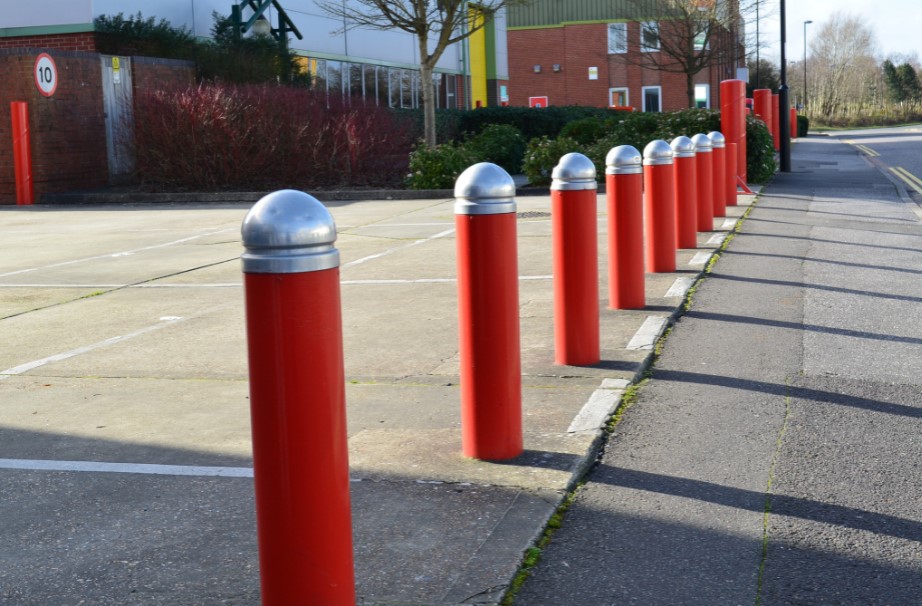Choose the Right Security Bollard Crash-Rating
Choosing the right security bollard crash-rating is a critical decision for enhancing security measures around sensitive or high-risk areas. This process involves evaluating various factors, including the level of protection needed against vehicle intrusions.
Bollard Crash-Ratings, as determined by industry standards, guide the selection process to ensure that the installed bollards provide an effective barrier that meets both safety and security requirements. This strategic approach helps mitigate potential threats and safeguard people and assets with the appropriate level of defense.
Understanding Bollard Crash-Ratings: ASTM Standards
Understanding Bollard Crash Ratings, particularly those set by ASTM International standards, is essential for selecting the right security measures for any facility. These ratings are a critical component of the decision-making process, as they provide a clear guideline on the bollard’s ability to withstand vehicular impacts. Bollard Crash-Ratings categorize bollards based on their performance in crash tests, ensuring they meet the required levels of security and protection.
The selection process involves analyzing the potential threats and determining the appropriate level of security needed. It’s not just about preventing vehicle access; it’s also about integrating these security features seamlessly into the surrounding environment without compromising on safety or aesthetics. ASTM standards offer a structured approach to evaluating the effectiveness of bollards in preventing unauthorized vehicle intrusion.
Key to this evaluation is understanding the different crash ratings:
- K4, K8, and K12 Ratings: These ratings indicate the bollard’s ability to stop a 15,000 lb vehicle traveling at 30, 40, or 50 mph, respectively.
- M30, M40, and M50 Ratings: Reflecting updates to the rating system, these indicate a bollard’s capacity to halt a vehicle of the same weight at similar speeds but under newer testing methodologies.
By carefully assessing these ratings, organizations can make informed decisions about which bollards to install. This ensures not only the physical security of a site but also contributes to the overall safety and well-being of the individuals within those spaces. The choice of bollard crash rating is a fundamental aspect of a comprehensive security strategy, highlighting the importance of selecting the right level of protection based on specific threat assessments and security goals.
Assessing Your Site’s Security Needs
Assessing your site’s security needs is a complex process that requires a thorough understanding of the potential risks and threats. This involves analyzing the location’s vulnerability to unauthorized vehicle access and identifying the areas that require the highest level of protection.
A comprehensive risk assessment should take into account past incidents, possible future threats, and the overall security posture of the surrounding environment. This step is crucial in determining the appropriate level of security and the specific bollard crash-rating necessary to mitigate those risks effectively.
It’s essential to consider the types of vehicles that could pose a threat, as different bollards are rated to stop vehicles of varying sizes and speeds. The Bollard Crash-Rating system, established by standards such as ASTM International, provides a framework for understanding how different bollards perform under impact. By evaluating the potential threats, decision-makers can select bollards with the proper crash rating to prevent vehicular entry in scenarios ranging from accidental implications to deliberate attacks.
Beyond immediate security concerns, assessing your site’s needs also involves planning for future developments. As urban areas expand and threats evolve, the security measures implemented today must be adaptable to tomorrow’s challenges. This forward-thinking approach ensures that investments in security infrastructure, like bollards, remain effective and relevant over time.
It requires collaboration between security professionals, urban planners, and other experts to anticipate changes and design a security strategy that is both resilient and flexible.
Engaging with professional consultants or security experts can significantly enhance the assessment process. These specialists bring a wealth of experience and can offer insights into industry best practices, emerging threats, and the latest technological advancements in bollard crash-rating and design.
Their expertise ensures that the selected bollards not only meet the current security requirements but also integrate seamlessly with the overall design and functionality of the site, providing adequate protection without compromising on aesthetics or accessibility.
The Role of Aesthetic in Bollard Selection
The design and appearance of bollards can be adapted to complement the architectural style and visual character of a site, ensuring that security measures enhance rather than detract from the environment. This approach allows for the seamless integration of security features into public spaces, commercial areas, and private properties, preserving the ambiance and aesthetic appeal.
The choice of materials and finishes for bollards is vast, ranging from stainless steel to concrete, and can include various coatings to match or contrast with the surroundings. This flexibility in design enables planners and security experts to create a security barrier that is not only functional but also visually pleasing.
When bollards are thoughtfully designed and well-integrated into a space, they can convey a sense of safety and order without creating a fortress-like environment. This subtle balance between security and design is crucial in areas frequented by the public, where the feel of the space is as important as its safety.
By prioritizing design alongside crash-rating requirements, it is possible to achieve a secure yet inviting environment. This holistic approach ensures that security measures are not only effective but also enhance the overall user experience, contributing to the creation of spaces that are both safe and attractive.
Durability and Maintenance Considerations
Choosing bollards that are built to withstand environmental conditions and potential impacts is crucial for long-term effectiveness and sustainability. The materials used in bollard construction, such as high-strength steel or reinforced concrete, play a significant role in their ability to resist wear and damage over time. The design of the bollards should facilitate easy maintenance and repair, ensuring that they remain functional without requiring excessive upkeep.
Maintenance routines for bollards vary depending on their location, material, and the level of threat they are designed to mitigate. Regular inspections are necessary to identify any signs of damage or wear that could compromise their structural integrity or crash-rating effectiveness.
The ease with which parts can be replaced or repaired is also a consideration, as this affects the overall cost of maintenance. Selecting bollards with a design that allows for quick and efficient maintenance can significantly reduce long-term operational costs.
The environmental conditions in which the bollards will be installed also influence their durability and maintenance needs. Bollards installed in coastal areas, for example, may require materials that are resistant to corrosion from saltwater, while those in areas with severe weather conditions might need to withstand heavy impacts or extreme temperatures. Understanding these environmental factors is crucial in selecting bollards that will maintain their functionality and appearance over time.
Considering durability and maintenance in the selection of security bollards ensures that the chosen solutions are cost-effective, long-lasting, and consistently perform their intended security function. This strategic approach to selection helps minimize future expenses related to repairs or replacements and maintains the integrity of the security perimeter without compromising on safety or aesthetic standards.
Installation Complexity and Costs
The complexity and cost of installing security bollards are critical aspects that must be considered during the selection process. Installation complexity can vary significantly based on the type of bollard, whether it is fixed, removable, or retractable, and the terrain where it will be installed.
These factors influence the installation time, the need for specialized equipment, and, ultimately, the overall project cost. Understanding the installation requirements early on helps in planning and budgeting for the project effectively.
Cost considerations extend beyond the initial purchase and installation. The long-term expenses associated with maintenance, potential repairs, and operational costs, like those for retractable bollards that require power, must also be evaluated. Selecting bollards that offer a balance between upfront costs and ongoing expenses can provide the most cost-effective solution over their lifespan.
The impact of the installation on the surrounding area is a factor that cannot be overlooked. For instance, the installation of deep foundation bollards could interfere with underground utilities, requiring additional planning and potential relocation of services. Such considerations are essential to prevent costly delays or modifications during the installation process.
Assessing the installation complexity and costs associated with security bollards is a multifaceted process that requires careful consideration of various factors. This assessment ensures that the chosen bollard solution is not only effective in enhancing security but also aligns with budgetary constraints and installation feasibility, leading to a successful and efficient security upgrade.
Regulatory Compliance and Safety Standards
Understanding and complying with regulatory compliance and safety standards is paramount when selecting security bollards. These regulations ensure that bollards are installed and operated safely, protecting both the public and the infrastructure they are designed to secure. Compliance with local, national, and international safety standards not only mitigates legal risks but also enhances the credibility and reliability of security measures.
Key considerations include:
- ADA compliance for pedestrian safety and accessibility.
- Local building codes that dictate installation practices and materials.
- Industry standards for crash ratings, such as ASTM or IWA, ensuring bollards meet specific impact resistance levels.
Navigating these regulations requires thorough research and possibly consultation with experts in security infrastructure. Failure to adhere to these standards can result in significant legal and financial repercussions, including fines, liability issues, and the potential for having to redo non-compliant installations. Therefore, it’s crucial to integrate compliance into the planning phase to ensure that all security enhancements meet the required safety standards.
The evolving nature of threats and technology means that standards are regularly updated. Staying informed about these changes is necessary to ensure ongoing compliance and to leverage the latest security innovations effectively. This proactive approach to regulatory compliance not only safeguards the physical premises but also demonstrates a commitment to public safety and security.
Regulatory compliance and safety standards are foundational elements in the selection and installation of security bollards. By prioritizing these considerations, organizations can ensure that their security measures are adequate, legal, and socially responsible, thereby protecting assets and individuals without compromising safety or accessibility.
Contact R3 Access
At R3 Access, we understand the importance of securing your premises with the right security solutions, including bollards that meet your specific security needs. Our team is here to guide you through the selection process, ensuring that you choose the most effective crash-rated bollards for your site. Contact us to learn more about how we can assist you in enhancing your security measures with high-quality, reliable bollards.
Follow us on linkedin


